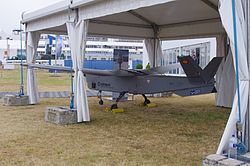Cassidian Atlante
| Atlante | |
|---|---|

|
|
| Type: | Unmanned aerial vehicle |
| Design country: | |
| Manufacturer: |
Airbus Defense and Space (formerly Cassidian Air Systems ) |
| First flight: |
February 2013 |
The Atlante , the name stands for A vión T áctico de L argo A lcance n o t ripulado E spañol, is a Spanish unmanned aerial vehicle .
Atlante was developed by the Spanish Center for Industrial Technology Development ( Centro para el Desarrollo Tecnológico Industrial - CDTI) and built by Cassidian Air Systems , part of the Airbus Group .
The unmanned prototype had its maiden flight in February 2013 at the Aeródromo de Rozas . The test flight was accompanied by a Cessna 172 and monitored by air traffic controllers from the nearby airport. The atlante has a transponder that works in mode 3 / C and thus shows the flight position and movements on the radar screen of the controller.
Atlante has been developed for both civil and military use and is used, for example, to monitor urban and rural areas, for search and rescue operations , in the event of natural disasters, forest fires or to monitor sporting events. The sensors for fire monitoring come from the company Meggitt .
- Technical specifications
- Length: 4.6 m
- Span: 8 m
- Height: 1.8 m
- Max. Takeoff weight: 520 kg
- Engine: 1
- Range: Radius: 220 kilometers around the control station
- Flight time: between 20 and 10 hours depending on the payload
- Service ceiling: 6000 m
- particularities
No runways are required to operate the Atlante, although it is equipped with a landing gear system so that it can be operated on runways. It can be operated in two modes either from unpaved runways or with a launcher via a catapult and land safely on the ground with a built-in parachute after the end of operation.